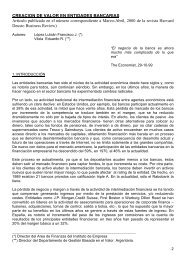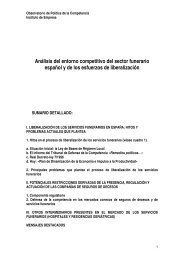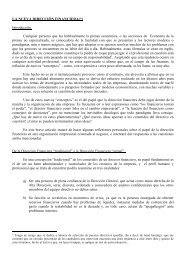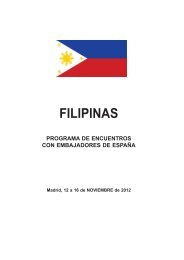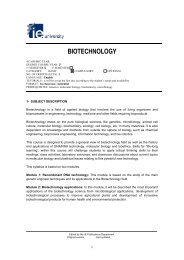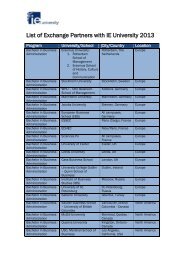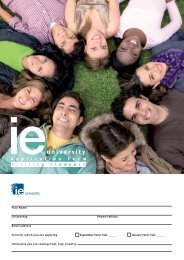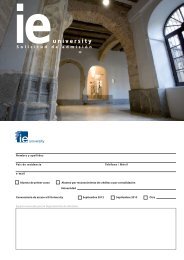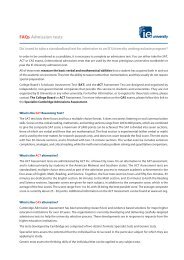SPECIALIZED WRITING - IE
SPECIALIZED WRITING - IE
SPECIALIZED WRITING - IE
You also want an ePaper? Increase the reach of your titles
YUMPU automatically turns print PDFs into web optimized ePapers that Google loves.
0<br />
<strong>SPECIALIZED</strong> <strong>WRITING</strong><br />
ACADEMIC YEAR:<br />
DEGREE COURSE YEAR:<br />
1º SEMESTER 2º SEMESTER X<br />
CATEGORY: BASIC COMPULSORY OPTIONAL<br />
NO. OF CREDITS (ECTS):<br />
LANGUAGE: ENGLISH<br />
TUTORIALS:<br />
FORMAT:<br />
PREREQUISITES:<br />
1. SUBJECT DESCRIPTION<br />
“Journalism largely consists of saying ‘Lord Jones is Dead’ to people who never knew that Lord<br />
Jones was alive”. G. K. Chesterton<br />
Journalism and Communication have undergone more changes in the current 21st Century tan<br />
in all of the 20th Century. In the present century, technological advances have increased the<br />
speed of information and improved images to incredible levels. The amazing rhythm set by new<br />
technologies in the last decade has caught the media and its managers off-guard.<br />
We live in a convulsive period of change and of adaptation to what new technologies bring us.<br />
Journalism and Communication are somewhere within our visual society. While many traditional<br />
newspapers observe how their online versions cannibalize their content, without finding a viable<br />
business model, the digital media, social media and citizen journalism are here to stay since<br />
never before has the credibility of media been so in question.<br />
But there are reasons to be optimistic: in the age of global communications, writing continues to<br />
be indispensable to inform and to communicate, and doing it with speed, rigor, style and<br />
singularity is the key to success.<br />
What is the profile of the 21st Century communicator? What codes should he know and manage<br />
so that his message not only reaches the maximum number of people but can also stand out<br />
among the enormous amount of messages that circulate every day, every hour, every minute on<br />
the Web? Given the boom of blogs and tweets, can anybody write? Can anybody be a<br />
journalist?<br />
This course aims to share the key levers that will allow one to navigate confidently in this new<br />
media scenario, in which the traditional media and the journalists of pen and tape recorder<br />
coexist with the new media and their multi-tasking reporters. Looking at the past to understand<br />
the present and anticipate the future, we will study century-old media and their successes, to<br />
learn what works in different platforms and how to write for different media. Which journalistic<br />
Edited by the <strong>IE</strong> Publications Department.<br />
Original version, . Last updated, .<br />
1⏐
genres survive and which are borderline between fiction and reality, between literature and<br />
journalism. What changes have been introduced in impartial and objective writing such<br />
phenomena as political correctness, the polarization of society and the 140 characters.<br />
2. OBJECTIVES AND SKILLS<br />
Students will be able to identify the different types of journalistic genres and the purposes they<br />
serve. By the end of the class, students will have a solid understanding of what distinguishes<br />
journalistic writing from other information and be able to create original journalistic articles.<br />
2.1. Conceptual objectives<br />
– Share with students the historical references, from the beginning of the 20th Century, so<br />
that they can understand the current media context.<br />
– Cover the different journalistic genres and formats<br />
– Specific characteristics of the written message for radio and television<br />
– The new media: write for the reader of for Google?: the journalistic language in texts<br />
and titles of digital media<br />
– The new markets: corporate communication and public relations, advertising, training<br />
and user manuals, human resources…<br />
– The new values: ethics and service information. NGO’s.<br />
If an image is worth more than one thousand words, what kind of message should accompany a<br />
strong image?<br />
2.2. Professional skills. Develop competencies and skills<br />
2.2.1 SPECIFIC for:<br />
– Not only correct use but adequate use of written language in the different media and<br />
channels.<br />
– News writing, chronicles, reports and other examples of journalitic genres.<br />
– Management of information for each section of different media, in line with their different<br />
styles.<br />
– Interviewing: the power of questions. Coaching and Journalism.<br />
– Preparing press releases, CVs and brochures.<br />
2.2.2. TRANSVERSALLY for:<br />
Improving synthesis, argumentation and critical logic skills<br />
Promoting and encourage free discussion and interchange of ideas and opinions<br />
Developing teamwork, problem resolution and conflict management<br />
Stimulate creativity when choosing topics, approach and presentation<br />
2.3. Learning outcomes<br />
After completion of the classes the student will be able to:<br />
– Establish and evaluate the key elements for an effective communication.<br />
– Define the creation, editing and information spreading processes.<br />
2⏐
– Practice the most important writing abilities.<br />
– Experience life in a Newsroom: Oral Presentations to class, role distribution<br />
– Collaborating with others<br />
– Managing information and organizing contents for covers<br />
– Being creative and exploring unusual angles of a subject<br />
– Managing difficult interviewees<br />
– Managing conflicts<br />
– How to facilitate the journalist’s work from institutional and corporate communication<br />
departments.<br />
3. CONTENT<br />
“The media is the message”, said MacLuhan. Knowledge of media is fundamental for<br />
journalists to do their jobs. The traditional media (newspapers, radio and TV), up to very<br />
recently paramount and dominant, have lost ground in faver of the new media born on Internet<br />
(webs, social media, blogs…). And to the digital versions of the former, you need to add others<br />
developed exclusively for the Web (newsletters, magazines for mobiles and tablets, …).<br />
To have a clear idea of the current media market, it is important to review all of them, know their<br />
history and relationship with other disciplines (fashion, beauty, cinema, music, cars,<br />
gastronomy, travel, finances, …), areas in which the journalist must learn how to navigate to<br />
understand the future of communication.<br />
INTRODUCTION: TRADITIONAL WRITTEN MEDIA<br />
SECTION 1. MAIN PRINCIPLES OF WRITTEN JOURNALISM “FROM THE TRENCHES”<br />
Journalistic genres:<br />
Journalistic genres in Audiovisual Journalism:<br />
SECTION 2. JOURNALISM AND LITERATURE<br />
SECTION 3. GENERAL PRINCIPLES OF WRITTEN JOURNALISM “FROM THE OTHER<br />
SIDE”: RELATIONSHIP WITH COMPAN<strong>IE</strong>S, BRANDS AND COMMUNICATION DIRECTORS<br />
SECTION 4. HOW TO WRITE FOR DIGITAL MEDIA: CITIZEN JOURNALISM<br />
4. METHODOLOGY AND ECTS WEIGHTED DISTRIBUTION<br />
The teaching methodology used during this course is fundamentally practical, paying special<br />
attention to class participation and sharing of each student, so that the learning process is<br />
useful, dynamic, inspirational and critical.<br />
1.- Teaching presentation covering the content of the program via teacher’s oral dissertation,<br />
comprehensive outlines and audiovisual documents<br />
2.- Individual and team projects that will occur throughout the course both in and out of class<br />
3.- Completion of a Guide of Segovia and its surrounding area for students and<br />
4.- Making of the <strong>IE</strong> Segovia Magazine, the students will be in charge of its design, execution<br />
and contents.<br />
3⏐
The distribution of the students' work will be the following:<br />
6 credits ECTS (6 x 25 hours/credit= 150 hrs. of student's work)<br />
6 credits ECTS (6 x 25 h/credit = 150 h. student’s work)<br />
Activities<br />
Classroom<br />
Hours<br />
Sessions Individual<br />
Preparation<br />
Hours<br />
Total<br />
Hours<br />
Lectures 13.5 9 13.5 0.54<br />
ECTS<br />
Practical assignments in<br />
class (Team work in class,<br />
role playing, PPT<br />
presentations, discussions of<br />
assignments)<br />
28.5 19 28.5 1.14<br />
Study, readings, case studies<br />
30 30 1.2<br />
reading and preparation<br />
Team work, responding to<br />
69 69 2.76<br />
client brief, development of<br />
pitch PPT presentations<br />
preparation, role play<br />
preparation<br />
Final Project 3 2 6 9 0.36<br />
Total 45 30 105 150 6<br />
5. EVALUATION SYSTEM<br />
GENERAL OBSERVATIONS<br />
– Each student can take 4 exams per subject in 2 consecutive courses.<br />
– It is mandatory to attend 70% of the classes. Students who do not comply with this<br />
percentage of attendance lose the 1st and second exams and go directly to the 3rd one.<br />
– Grading for the students on make-up exams will be subject to the following rules:<br />
• Those students who failed the subject in the first round of exams, pass to the 2nd<br />
session, except those who do not comply with the percentage of attendance to<br />
class and go directly to the 3rd session.<br />
• The maximum grade that a student may obtain in the 2nd exam session is 8.<br />
– In the case a student receives a failing grade in the class, the student will be able to<br />
make-up for the failing grade during “convocatoria extraordinaria” in July. The make-up<br />
exam will consist of a written exercise.<br />
4⏐
EVALUATION AND WEIGHTING CRITERIA<br />
The course will be graded with the following criteria:<br />
– 40% through the continuous evaluation of the practical assignments and activities done<br />
daily in class, together with those assigned to be done outside of class<br />
– 30% class participation, motivation and teamwork<br />
– 30% end of the year project<br />
Absences will need to be justified. When a student misses a class, he/she should send an email<br />
to the teacher and fellow students to ask for information regarding assigned projects and<br />
present them in the following class.<br />
5⏐


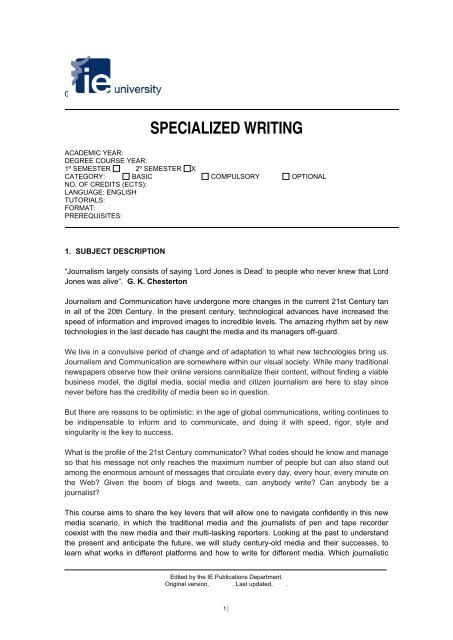
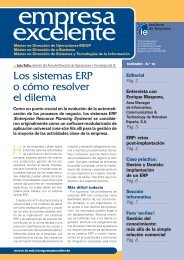
![Change Management Workshop Program Brochure[pdf] - IE](https://img.yumpu.com/22502183/1/184x260/change-management-workshop-program-brochurepdf-ie.jpg?quality=85)
